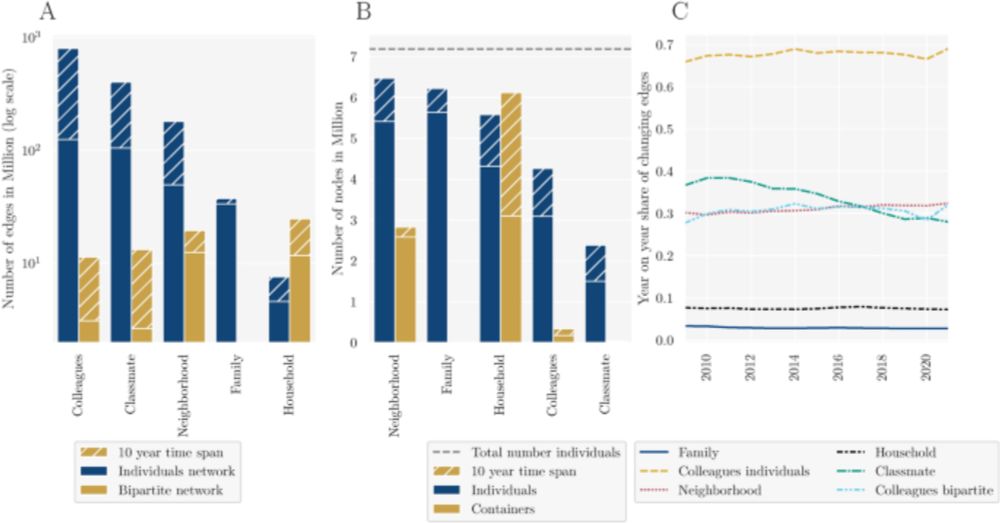11/
The work was led by Jolien Cremers, Benjamin Kohler, Benjamin F. Maier and done in collaboration with Stine N. Eriksen, Johanna Einsiedler, Frederik K. Christensen, @sunelehmann.com, David D. Lassen, Laust Hvas Mortensen. We are grateful for funding by the Villum Foundation.
29.07.2025 15:35 — 👍 1 🔁 0 💬 0 📌 0
10/
We build on earlier work by @drtomemery.bsky.social and colleagues, who constructed the Dutch administrative network 🇳🇱.
Our network adds temporal depth and enables computationally scalable analysis at the national level.
29.07.2025 15:35 — 👍 1 🔁 0 💬 1 📌 0
9/
This dataset opens new doors for research on:
– Inequality & opportunity
– Social cohesion
– Spatial structure
– Peer effects
…all grounded in real, registry-based, population-wide data.
29.07.2025 15:35 — 👍 2 🔁 0 💬 1 📌 0
8/
To handle 1.4 billion ties, we used a bipartite network representation — linking individuals to shared foci like workplaces, schools, or households.
This reduced edge count by up to 98%, making large-scale analysis feasible.
29.07.2025 15:35 — 👍 0 🔁 0 💬 1 📌 0
7/
Social connectivity is highly unequal:
The top 20% of individuals hold nearly half the ties in some layers.
Over time, the well-connected in one layer become central in others too — interlayer centrality accumulates.
29.07.2025 15:35 — 👍 1 🔁 1 💬 1 📌 0
6/
📍 Geography matters.
People are much more likely to be socially connected if they live nearby.
Probability of connection drops steeply after 100m — confirming that spatial proximity underpins social proximity.
29.07.2025 15:35 — 👍 0 🔁 1 💬 1 📌 0
5/
By combining and weighting layers, we uncover a familiar pattern: The average shortest path is around 6 — echoing the “six degrees of separation” concept.
But only when accounting for the structure and strength of ties.
29.07.2025 15:35 — 👍 0 🔁 1 💬 1 📌 0
4/
Social network position reflects income:
Higher-income individuals tend to have more ties — especially when past ties are included.
The more central you are, the higher you tend to be in the income distribution.
29.07.2025 15:35 — 👍 0 🔁 1 💬 1 📌 0
3/
We find that social ties persist and resurface — former classmates become neighbors, colleagues become family.
Connections across life stages create dense, overlapping social paths.
29.07.2025 15:35 — 👍 1 🔁 2 💬 1 📌 0
2/
We mapped social ties through five layers:
👨👩👧 Family
🏠 Households
📍 Neighborhoods
🎓 Classmates
💼 Colleagues
…across 2008–2021. The result is a dynamic, multiplex network of the entire population.
29.07.2025 15:35 — 👍 0 🔁 0 💬 1 📌 0

While human behavior and the data describing it evolve over time, fairness is often evaluated at a single snapshot. Yet, as we show in our newly published paper, fairness is dynamic. We studied how fairness evolves in dropout prediction across enrollment and found that it shifts over time.
21.07.2025 08:02 — 👍 4 🔁 2 💬 1 📌 0
Can AI interviewers match humans in qualitative interviews?
We found:
🤖 AI asked more questions, yielding longer interviews
🧠 Responses to specific questions were longer in human-led interviews
📏 But response quality—specificity & relevance—was similar
See more below 👇
23.07.2025 20:32 — 👍 2 🔁 0 💬 0 📌 0
Associate Prof. of Behavioral Science and Director of the IBT @HSGStGallen
#mobilesensing, #dailybehavior, #personality, #machinelearning, #explainableAI
Postdoctoral Research Scientist @Meta. I like computers, cities, and social networks.
https://drew-johnston.com
computational social scientist
I’m an Econ AP at Brown: www.jessebruhn.com
My long term research agenda involves saying yes to everything and then repeatedly disappointing everyone who thought I’d make a good coauthor.
Kellogg Chair of Technology, Kellogg School of Management, Northwestern University
Behavioral Economist. Assistant Professor at Frankfurt School of Finance & Management. www.felixchopra.com
Associate Professor, Center for Social Data Science(SODAS), University of Copenhagen. Background in sociology, substantive research in civic participation, methods research in mixed methods approaches to digital data.
networks, contagion, causality
faculty at MIT
PhD Student in Social Data Science, University of Copenhagen
AI & Society | Algorithmic Fairness | ML | Education Data Science
https://tereza-blazkova.github.io/
Your friendly neighborhood suneman
https://en.wikipedia.org/wiki/Professor_Farnsworth
Yale SOM professor & Bulls fan. I study consumer finance, and econometrics is a big part of my research identity. He/him/his
Education economist @ BU Wheelock & Economics Dept | Wheelock Education Policy Center | Co-editor @ JHR | White House CEA 2022-23 | www.joshua-goodman.com
Ledende økonom i tænketanken Kraka. Tal, økonomi og politik. Hjernerystelseshader. Fang mig på 4O76762Ʒ.
Journalist, Weekendavisen
Copenhagen, Denmark
Assistant Professor of Economics at Lund University. I run experiments to study people's behavior. Especially interested in incentives and social preferences.
My webpage: https://sites.google.com/site/polcamposmercade
Assistant Professor in Economics at the University of Copenhagen, previously researcher at the New York Fed. Labor, social policy, inequality.
Professor of Sociology | Social Science DGS | Education and Social Mobility | ERC Grantee | The K in KHB | Winner of Boudon + Goodman Awards | I Like Quantitative Methods and Great Sociology
Economics professor at the Norwegian Business School | www.jon.fiva.no


